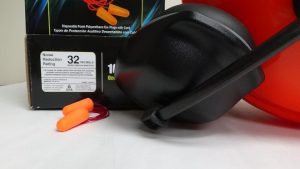By Heather N. Kolich, ANR Agent, UGA Extension Forsyth County

With warmer weather, many of us are enjoying more time outside. Unfortunately, many motorized outdoor toys and tools create noise at levels that damage hearing. Noise-induced hearing loss can have life-impacting consequences. With the use of hearing protection devices, however, we can enjoy the benefits or motorized tools and still preserve our precious hearing.
How hearing loss occurs
Sound waves create vibrations in our ears. The vibrations ripple through the bones of the middle ear, into fluid of the inner ear, and move a membrane studded with hair cells. Microscopic projections on the hair cells bump up and down and translate sound waves into electrical signals that make sense of the sound in our brains. Loud sounds damage and kill the hair cells, which don’t grow back.
Our hearing is at risk from sounds that are 85 decibels (dB) and louder. The louder sound is, the quicker hearing damage can happen. In some cases, one extremely loud noise, like an explosion, causes sudden, permanent hearing loss. Prolonged or repeated exposure to noise over 85 dB causes gradual hearing loss that may be hard to notice. It can also cause tinnitus, a sense of buzzing in one or both ears, or a roaring sound in the head, that can be hard to tune out. The U.S. Occupational Safety and Health Administration established worker safety standards for noise exposure, but over half of working-age people with noise-induced hearing loss were not exposed to workplace noise.
Common sounds that contribute to hearing loss
Many of our everyday sounds are over 85 decibels – loud enough to cause hearing loss. As equipment ages, it can get louder when operated. Battery powered lawn equipment tends to be quieter than gas powered equipment, but these may still exceed safe noise limits.
Sound levels of common yard and home equipment
| Yard tools | Sound in dBs | Other tools | Sound in dBs |
| Edger | 86 | Vacuum cleaner | 87 |
| Riding lawn mower | 90 | Air compressor | 92 |
| Weed eater | 96 | Wet/dry vac | 94 |
| Leaf blower | 99 | Pressure washer | 100 |
| Hedge trimmer | 103 | Chain saw | 110 |
Noise has the most impact on the person using the equipment, but the sound level can be damaging to others as far as 50 feet away. When several pieces of equipment operate at the same time – as on a sunny weekend in the neighborhood or when the landscape management crew shows up at the office building – noise level escalates. In this situation, noise levels can exceed 85 dB at a distance of 200 feet or more from the equipment.
Consequences of hearing loss
Both children and adults are at risk for noise-induced hearing loss. In children, hearing loss can cause delayed language development and poor performance in school. For adults, hearing loss can cause problems understanding instructions in the workplace, which can lead to lower employability and higher risk of injury. In home and social settings, hearing loss interferes with ability to understand and participate in conversations. This can lead to disengagement, depression, decline in thinking and memory skills, and dementia.
How to protect from hearing loss
Protecting against noise-induced hearing loss is simple: Wear earplugs or earmuffs when operating or near loud equipment. Hearing protection devices should be labeled with a Noise Reduction Rating (NRR). An NRR of 12 reduces the noise reaching your ears by 12 decibels, sufficient for using an air compressor (92 dB – 12 dB = 80 dB). A chainsaw (110 dB) requires NRR 26 or higher. The goal is to use enough protection to reduce noise below 85 dB, not to block all sound. We still need to hear warnings and danger sounds.
Hearing is important for quality of life. The impact of hearing loss isn’t just personal; it extends to family, friends, and coworkers, as well. Let’s take hearing protection seriously for ourselves and our loved ones.